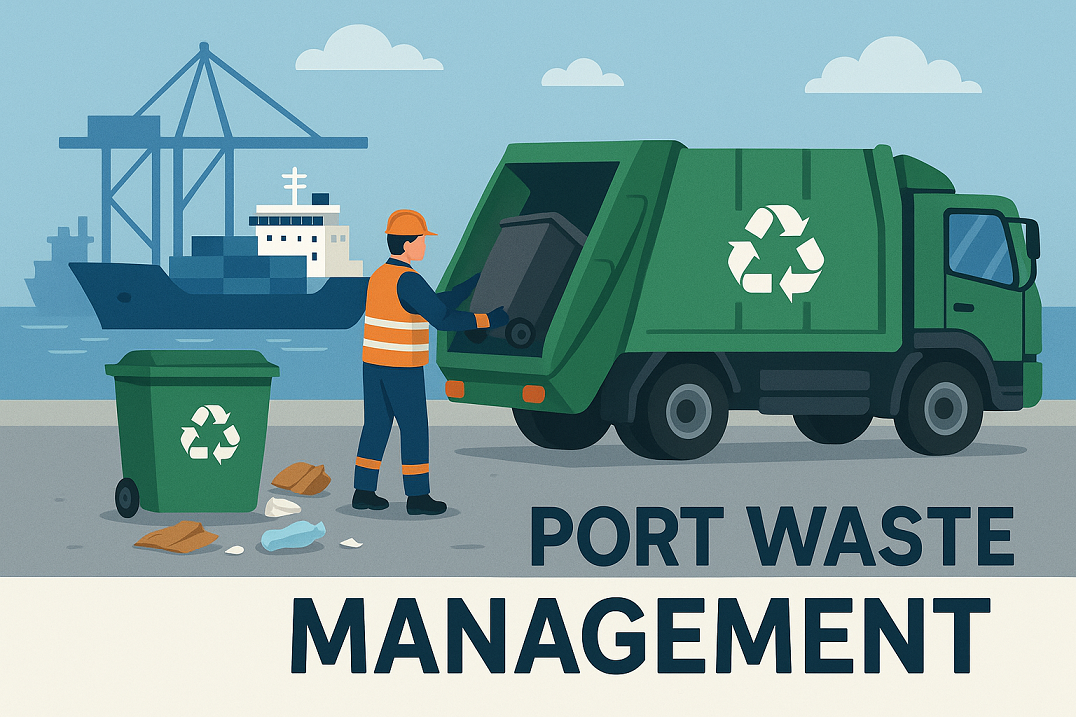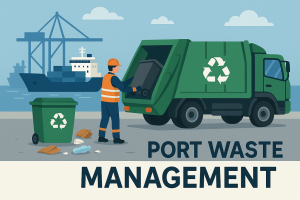Ports serve as vital nodes in global trade networks, facilitating the movement of goods across continents. However, this economic activity generates substantial waste, ranging from routine ship-generated refuse to hazardous operational byproducts. With increasing environmental awareness and stricter regulations, port waste management has become a critical priority for the maritime industry.
Understanding Port Waste: Sources and Categories
Port waste management begins with recognizing the diverse types of waste generated in maritime operations. Each category presents unique challenges and requires specific handling approaches to ensure environmental protection and regulatory compliance.
A. Ship-Generated Waste
Ships produce various waste streams during normal operations:
- Solid Waste: Includes food scraps, packaging materials, and plastics (regulated under MARPOL Annex V)
- Liquid Waste: Comprises bilge water, sewage, and graywater (regulated under MARPOL Annex IV)
- Hazardous Waste: Encompasses oily sludge, chemicals, and battery waste (regulated under MARPOL Annex I & II)
B. Cargo-Associated Waste
Cargo operations contribute significantly to port waste:
- Dunnage materials (wood, plastics used to secure cargo)
- Dust and residues from bulk cargo like coal or grains
- Container cleaning waste including chemical residues and cargo remnants
C. Port Operational Waste
Port facilities themselves generate various waste streams:
- Maintenance debris including scrap metal and paint chips
- Dredging sediments often contaminated with heavy metals
- Stormwater runoff carrying pollutants from paved surfaces
Understanding these categories helps ports develop targeted waste management strategies that address each waste stream effectively.
Regulatory Framework for Port Waste Management
The legal landscape for port waste management is complex, involving international conventions, regional directives, and local regulations. Compliance is not optional—it’s a fundamental requirement for port operations.
International Regulations (MARPOL)
The International Maritime Organization’s MARPOL Convention sets global standards:
- Annex I: Regulates oil waste including sludge and bilge water
- Annex IV: Governs sewage discharge from vessels
- Annex V: Addresses garbage disposal, particularly plastics
- Annex VI: Controls air pollution from waste incineration
EU Directives
European ports must comply with additional requirements:
- Port Reception Facilities Directive (2019/883): Mandates adequate waste collection services
- Waste Framework Directive: Promotes recycling and circular economy principles
Regional & Local Policies
Specific regions have implemented tailored regulations:
- US Clean Water Act: Requires stormwater pollution prevention plans
- China’s Yangtze River Protection Law: Imposes strict waste disposal rules
These regulations create a comprehensive framework that ports must navigate to operate legally and sustainably.
Port Waste Treatment Technologies
Modern ports employ a range of technologies to manage diverse waste streams efficiently. The choice of technology depends on waste type, volume, and local environmental considerations.
Advanced Treatment Solutions
| Technology | Application | Advantages |
|---|---|---|
| Recycling Stations | Plastics, metals, glass | Reduces landfill dependency |
| Oily Water Separators | Bilge water treatment | Ensures MARPOL compliance |
| Bioremediation | Organic waste treatment | Environmentally friendly process |
| Waste-to-Energy (WtE) | Incineration with energy recovery | Generates operational power |
| Smart Bins (IoT-enabled) | Real-time waste monitoring | Optimizes collection routes |
Case Study: Port of Rotterdam’s Waste Innovation
The Port of Rotterdam has implemented a comprehensive waste management system that:
- Recycles 80% of ship-generated waste
- Uses AI-powered sorting systems for maximum efficiency
- Converts non-recyclable waste into alternative fuel sources
This integrated approach demonstrates how technology can transform waste management in large port environments.
–
Best Practices in Global Ports
Leading ports worldwide have developed innovative approaches to waste management that balance environmental and operational needs. These best practices offer valuable models for other ports seeking to improve their waste systems.
A. Singapore: The Zero-Waste Model
Singapore’s port leads in zero-waste innovation with mandatory waste reporting for ships and advanced sorting at Pulau Semakau landfill. Its strict environmental policies and cutting-edge waste processing set global benchmarks for sustainable port operations. Singapore’s ports have implemented:
- Mandatory waste reporting for all visiting vessels
- Advanced sorting facilities at the Pulau Semakau landfill
- Strict penalties for non-compliance with waste regulations
B. Port of Los Angeles: Green Port Initiative
The Green Port Initiative transforms waste through 100% reuse of dredged materials and advanced stormwater filtration systems. As North America’s busiest port, it demonstrates how large-scale operations can achieve both efficiency and environmental stewardship. The Green Port Initiative features:
- 100% reuse of dredged materials in construction projects
- Advanced stormwater filtration systems
- Comprehensive recycling programs for operational waste
C. Port of Hamburg: Circular Economy Pioneer
Hamburg converts cargo residues into biofuels and fosters public-private partnerships to close resource loops. This circular approach makes it Europe’s leader in turning port waste into valuable secondary raw materials. Hamburg’s circular approach includes:
- Converting cargo residues into biofuel
- Public-private partnerships for waste innovation
- Closed-loop systems for packaging materials
These examples demonstrate that effective waste management requires both technological investment and organizational commitment.
–
Future Trends in Port Waste Management
The future of port waste management is being shaped by technological innovation and evolving environmental standards. Ports that anticipate these changes will gain a competitive advantage.
Emerging Technologies
- AI and Machine Learning: For predictive waste management and illegal dumping detection
- Robotic Sorting Systems: Increasing accuracy and speed of waste separation
- Blockchain Tracking: Ensuring transparency in waste disposal chains
Sustainability Initiatives
- Biofuels from Organic Waste: Creating value from waste streams
- Plastic Upcycling: Transforming waste into construction materials
- Zero-Waste Certification: New standards for port sustainability
Regulatory Developments
- Tighter MARPOL Amendments: Stricter controls on ship waste
- Carbon Pricing Mechanisms: Incorporating waste into emissions calculations
- Extended Producer Responsibility: Holding shippers accountable for waste
These trends indicate a future where waste management becomes increasingly integrated with overall port operations and sustainability strategies.
–
Conclusion: Building Sustainable Ports for the Future
Effective port waste management is no longer optional—it’s a critical component of modern maritime operations. By implementing comprehensive waste strategies that combine regulatory compliance, advanced technologies, and innovative practices, ports can significantly reduce their environmental impact while maintaining operational efficiency.
The examples from leading global ports demonstrate that sustainable waste management is achievable and economically viable. As technology continues to evolve and regulations become more stringent, ports that invest in modern waste solutions will be better positioned for long-term success.
Key Action Points for Ports
-
Conduct a comprehensive waste audit to understand your specific waste streams
-
Invest in appropriate technologies that match your waste profile and volume
-
Develop partnerships with waste management specialists and technology providers
-
Train staff in proper waste handling and new technologies
-
Monitor regulatory changes to ensure ongoing compliance
By taking these steps, ports can transform waste management from a compliance obligation into a strategic advantage that supports both environmental goals and business objectives.
By: Reza Karimpour, PhD.



